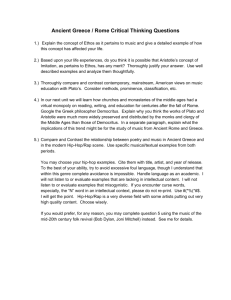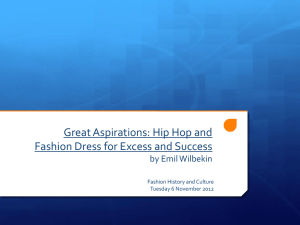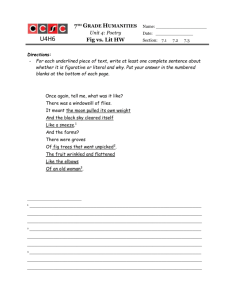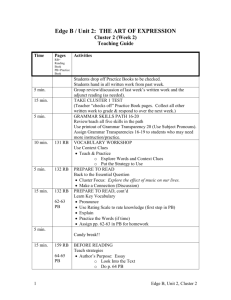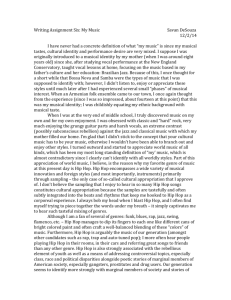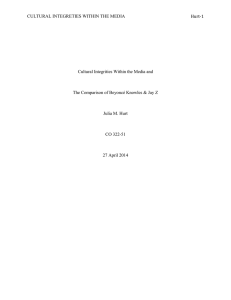ENG102-PersuasiveEssay
advertisement
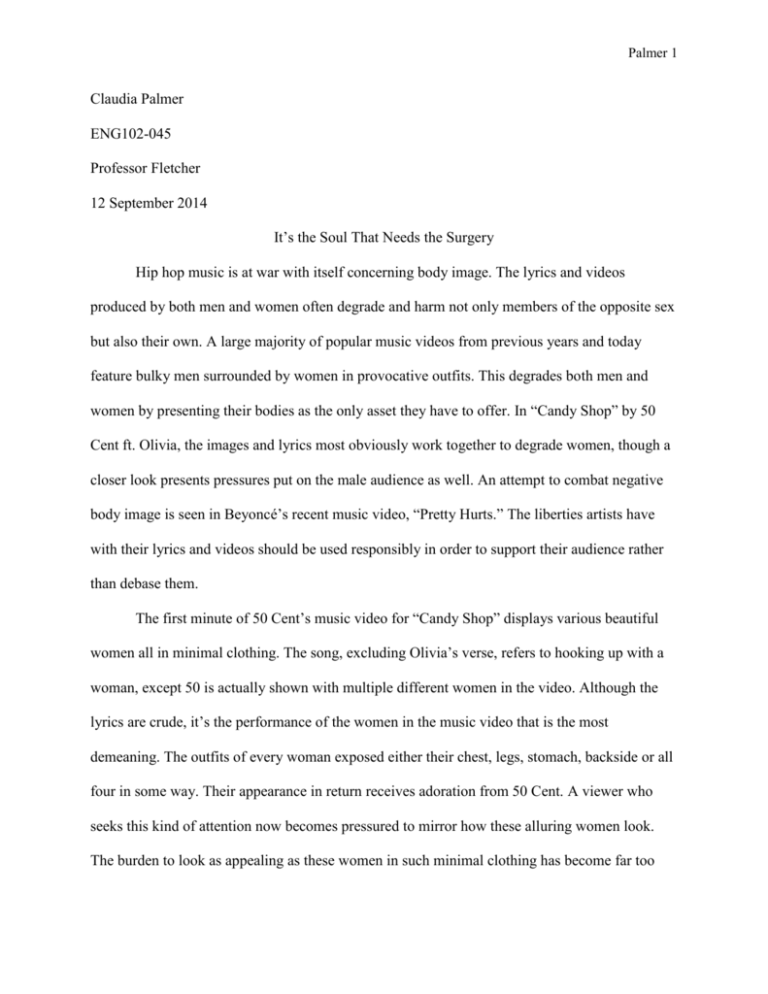
Palmer 1 Claudia Palmer ENG102-045 Professor Fletcher 12 September 2014 It’s the Soul That Needs the Surgery Hip hop music is at war with itself concerning body image. The lyrics and videos produced by both men and women often degrade and harm not only members of the opposite sex but also their own. A large majority of popular music videos from previous years and today feature bulky men surrounded by women in provocative outfits. This degrades both men and women by presenting their bodies as the only asset they have to offer. In “Candy Shop” by 50 Cent ft. Olivia, the images and lyrics most obviously work together to degrade women, though a closer look presents pressures put on the male audience as well. An attempt to combat negative body image is seen in Beyoncé’s recent music video, “Pretty Hurts.” The liberties artists have with their lyrics and videos should be used responsibly in order to support their audience rather than debase them. The first minute of 50 Cent’s music video for “Candy Shop” displays various beautiful women all in minimal clothing. The song, excluding Olivia’s verse, refers to hooking up with a woman, except 50 is actually shown with multiple different women in the video. Although the lyrics are crude, it’s the performance of the women in the music video that is the most demeaning. The outfits of every woman exposed either their chest, legs, stomach, backside or all four in some way. Their appearance in return receives adoration from 50 Cent. A viewer who seeks this kind of attention now becomes pressured to mirror how these alluring women look. The burden to look as appealing as these women in such minimal clothing has become far too Palmer 2 large as a result of hip hop videos such as “Candy Shop.” However, the absence of clothing on a woman isn’t always meant to be demeaning, it is sometimes to prove a point. Beyoncé’s music video for “Pretty Hurts” follows her as she portrays a young girl navigating the pageant world. She wears a swimsuit, revealing dress, and short shorts and tops to show what is expected of women today. The music video demonstrates the extensive and sometimes bizarre measures that girls must take in order to look their best in the eye of the judges and even further than that, society’s. They hairspray their clothes to stay tight to their body, Vaseline their teeth to prevent dry mouth, squeeze into dresses, wax their faces and bodies, and spend hours on their hair and makeup. However, these measures although difficult, seem minute when compared to the purging of food and extensive exercise many girls resort to. Although the portrayal of eating disorders and obsession over image in the pageant world in “Pretty Hurts” is stereotypical, it also applies to everyday girls and women. Negative body image is not an issue exclusive to the pageant world, it’s everywhere. Hip hop culture is a large area from where it stems. In music videos such as “Candy Shop,” the only women that are present are either bodacious, extremely fit, or an even harder and usually impossible to obtain, combination of both. Much of the female audience will therefore conclude that they must fit this mold in order to be considered a woman worthy of attention in the culture of hip hop. This is hurtful, as Beyoncé illustrates, because it leads to dangerous measures such as eating disorders, over-exercise, and mental instability, which is shown by her having a mental break down at the end of “Pretty Hurts.” When searching for who to blame for the types of women used and their behavior in music videos like “Candy Shop” many may go straight to the artist 50 Cent, who is a man, and therefore blame men. However, that neglects some very important scenes from the music video, Palmer 3 the ones that include the artist Olivia. In her scenes, like the other women, she too is in lingerie and tight clothing. Her scandalous outfits accompany her even more scandalous dance moves and lyrics. An audience member who was at first offended by 50 Cent’s use and abuse of women’s bodies may second guess themselves. “Since Olivia is complying to 50’s demands and offering sexual innuendos through her lyrics in return, does that make it okay? Is that how I should act as well?” the audience may find themselves asking. When it is unidentified girls looking a certain way and doing questionable things it is easier for the audience to resist being influenced by their looks and behavior. However, when it is a well-known celebrity condoning this type of self promotion, the audience may feel the urge or pressure to be like them. Beyoncé, at least in respect to her “Pretty Hurts” video, would oppose Olivia’s performance along with the rest of the “Candy Shop” video. In the “Pretty Hurts” video Beyoncé is trying to inform her audience of the alterations many women make in order to look that way. This can be connected to the women in the “Candy Shop” video. They do not naturally look as they appear, you don’t see the behind the scenes preparations, you see what the producers want you to see. In this respect, 50 Cent cannot take full responsibility for the objectifying of women in his video. It is what was popular and is still popular today. He too is a product of society that is just trying to sell his music, which speaks to a larger problem. In 50 Cent’s video the girls are in competition for his attention and it is not looked down upon. In contrast, Beyoncé is trying to discourage this idea of competition between girls and fight the idea that they must look a certain way. It would help the audience of 50’s video, if they were feeling uneasy and pressured to alter their appearance, to watch Beyoncé’s video. She sympathizes with young girls and women who are trying to achieve a most of the time impossible body with her lyrics when she sings “tryna fix something but you can’t fix,” and Palmer 4 pushes inner beauty by saying “what you can’t see, it’s the soul that needs the surgery.” A very important addition to my argument that hip hop is in conflict with itself over body image is the actuality that women are not the only victims. In the “Candy Shop” video 50 Cent is shown shirtless, greased up, and looking extremely buff. This in return creates pressures for the male audience. They will feel as though if they want to be a man, and like 50 Cent have the attention of attractive women, they must look like him. This would require countless months of going to the gym for hours, and they still may not get the results they want because everyone is built differently. This leads to negative body image in men but also degrades them. 50 Cent is objectifying himself in his video by being shirtless singing that he can “take you to the candy shop.” He can sexually satisfy a woman but that’s it, he doesn’t mention anything about the love or support he can give. For some time now I have begun to feel uneasy about hip hop culture and how it has come to display it’s own ideal behaviors and body type. I thought 50 Cent’s video was distasteful. I thought the girls were all gorgeous but their behavior also made me think they were unpleasant to look at. Although I did not feel alone in my confusion and struggle over how to interpret what I was seeing and listening to, I felt as though I didn’t have a say or that there was not much I could do. That is why Beyoncé’s video was so refreshing to me. It was one of the first I saw, or that I at least really remembered, that was compassionate of the viewer and went against popular hip hop culture. It all comes down to the viewer needing to be in control of how they react. I think the majority of female viewers reactions to 50 Cent’s video would be similar to mine. However, I do not think the male population would be affected as harshly by 50’s shirtless-ness as the females are by the ideal women’s bodies shown in the video. As for the Palmer 5 “Pretty Hurts” video, I would expect most females to sympathize with Beyoncé’s character and most males to think it was at least somewhat eye-opening. In this instance, hip hop being at war with itself is a good thing. Questionable, and in my opinion negative, ideals are now being challenged and opposed by not only the general public but, influential members of the hip hop community. Negative body images develop from many other mediums and not just hip hop music videos however, using hip hop itself to combat it is a step in the right direction.

